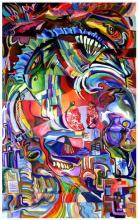May 18-22, 2015
CHID is proud to be a co-sponsor of Visual Ecologies and Solidarities (VES), a week-long set of linked lectures, conversations, and panels on the power of art in the Americas. Linked to a CHID and a CHID/Honors Study Abroad program, VES brings artists and activists from Guatemala, Martinique and Peru to the University of Washington in an effort to emphasize the principles of reciprocity, critical engagement, and collaborative scholarship that guide CHID International. This group of accomplished artists provides invaluable opportunities for new connections and possibilities for cultural agency in the Americas.
For more information on the events in this series, visit our events page.
Artist Biographies
Mauricio Delgado is an award-winning visual and performance artist, trained at the Institute of Visual Arts Edith Sachs. His work has been showcased internationally in Cuba, El Salvador, the United States and throughout Peru. His is active in public, collaborative and multi-media artistic production. His well-reviewed individual exhibit, “Between Flowers and Misfortunes”, like much of his work, engages the themes of memory, rights, and violence. He was also involved in the collaborative project, “Peruvian Art after the Truth and Reconciliation Commission.”
Jorge Miyagui is a visual artist, trained at the Pontificia Universidad Católica del Perú. His work has been the subject of solo exhibitions in Helsinki, Finland and various cities in Peru, and has been included in various collective exhibitions in Argentina, Chile, Venezuela, Germany, Spain, the United States. His work in countercultural projects, alternative cultural organizations, and public artistic interventions has been featured in various publications in Perú, Argentina, Holland, and Finland. He has also been a featured speaker at many academic conferences and events in Peru and internationally. He has been a member of the Aguaitones Collective (1998-2001) and the Forum for Cultural Solidarity (2004-2009). Currently he is involved in the following collective projects: the Muralist Brigade, the Averno, and the Traveling Museum: Art for Memory (Museo Itinerante Arte por la Memoria).
J. Carlos Pinto (image above) is an artist from Guatemala who has been working for the past 12 years in New York. Pinto’s artwork is poignantly aggressive and projects a revolutionary declaration. The scope of his art covers abstract painting, tile work, wood work, stencil spray, and use of non-biodegradable plastic and glass. Most of Pinto’s media comes from salvaged material and found objects. His legacy, as he sees it, is to be known as an artist who demands change to a Green Revolution.
Laurent Valère is a self-taught artist from the French Caribbean island of Martinique who works primarily in monumental concrete sculpture and found-object collage. He is best known for a memorial to the slave trade made up of 15 2.5-meter tall busts known as "Cap 110" (the nautical heading that links West Africa to Martinique) and a massive underwater sculpture of the Afro-Caribbean water deity known in Martinique as Manman Dlo or Mami Wata.
Sponsored by the Comparative History of Ideas Program and the Department of French and Italian, with additional support from the School of Art, the Simpson Center for the Humanities, the Department of Spanish and Portuguese, Latin American and Caribbean Studies, UW Honors, International Programs and Exchanges and the Office of Global Affairs.



